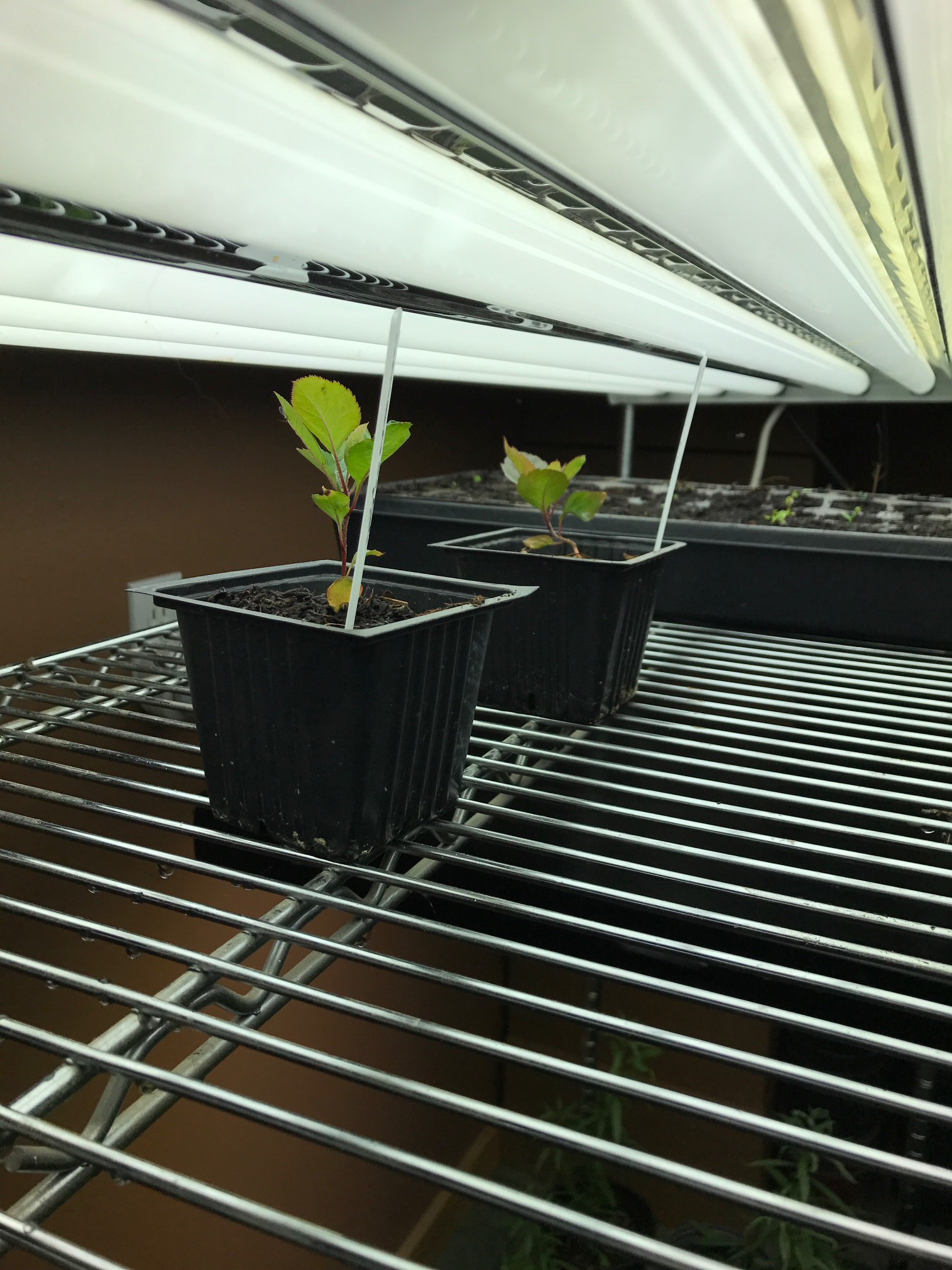Propagating trees from seed is very rewarding, relatively easy to do and will save you a bundle of money. If your property design requires planting dozens or even hundreds of trees then it makes complete sense to grow trees from seed. However, it’s important to understand some particulars about the process.
This post comes from the perspective of growing in a temperate climate (North Idaho) in zone 6a. However, it’s a good idea to plan for at least one growing zone colder than the zone where you are located. For example, the bulk of our trees and plants are cold hardy down to zone 5 or lower. Another crucial point is to understand your individual microclimate. Here in North Idaho there can be a drastic difference between properties a mile or less apart. The valleys around here become frost pockets and have shorter growing seasons than many of the “mountain” or sloped properties. It’s good to know your USDA hardiness zone as a starting point but you need to dig deeper in order to understand your individual site. With that in mind it’s recommended that you design and plant for your site.
Breeding Systems
Self Pollinizing trees have both male and reproductive parts and therefore, they generally produce the same plant characteristics as the parent plant. However, there are some minor adaptations that are occurring with each successive generation. The trees that survive become accustomed to the local conditions.
Cross Pollinizing trees do not possess both male and female reproductive parts and require another tree for pollination, in order to set fruit. In other words if you want to grow that Honey Crisp Apple you need to add another apple tree like Golden Delicious to ensure cross pollination.
Let’s take our example a little farther to illustrate. If you love your Honey Crisp apple tree so much you want more then growing from seed is not going to work, you need to buy a cloned seedling tree in order to get this specific cultivar. If you planted a Honey Crisp apple seed you will likely get an apple that is some combination of the Honey Crisp, the rootstock and also the apple the tree was crossed with, in this case a Golden Delicious. It might take hundreds of attempts to get most of the plant characteristics of the original parent tree. However, if you are just looking for fruit that is edible and useful then definitely try and grow some from seed. If you take 5 seeds from the same apple and grow them until they produce fruit they will all be slightly different but very likely useful in many ways. it’s going to be a grand experiment!
On the other hand, if you grow chestnut from seed you will get a virtual replica of the parent tree with the same quality and characteristics. Additionally, if you are growing non fruiting trees like Sugar Maple or Black Locust you will have no problem producing those trees. For specifics of each tree species conduct some more research to see the differences in reproduction by seed. There are also self pollinizing fruit trees that will be much closer to their parent like: peach, apricot and sour cherry.
Seed Growing Methods
There are two main ways, with lots of variation, to grow trees from seed: fall sowing and artificial germination. Both of these techniques assume that you are using trees that will grow in your climate. Fall sowing is letting nature take its course regarding preparation and germination of seed. You may help out some by growing them in a bed protected from pests and extreme weather. Artificial germination is growing from seed indoors in a controlled environment. Both have their advantages and disadvantages
Stratification and Scarification
In horticulture, the terms stratification and scarification have to deal with breaking embryonic dormancy. Stratification, or pretreatment of seed, is mimicking natural winter conditions. Frost and weathering action work to soften the seed and break dormancy once the weather starts to warm. Many trees require stratification but among those there are different time periods. Natural conditions vary which is why trees put out so many seeds to deal with high rates of mortality. Outdoor winter conditions of cold and moist can be mimicked by using a refrigerator to stratify seeds.
Scarification is breaking down the hard seed coat in a way that eventually allows moisture to imbibe into the seed. This natural process can be done through years of freezing and thawing, moving through an animals digestive system or even fire in some cases. We can simulate this process in many ways but here are two common methods: 1. Use a file, sandpaper or knife to nick the seed. 2. Use hot water (almost boiling) to break down the hard seed coat. A common tactic is to heat water up to a boil, let sit until no longer boiling, add the seed and then let sit for 12-24 hours. The seeds that are able to uptake water will sink to the bottom of the container.
Fall Sowing
This is a very simple technique with lots of advantages. First, there is no need to stratify the seed, it will happen naturally outdoors. Sew the seed in the desired location outside, in the fall, and you are done! One method is to heavily sew seed in the final location that you want the trees and then thin as appropriate when they begin to mature. In this case, the trees that make it are in their final position and well adapted to the site without any threat of transplant shock. Another way is to sew seed in “nursery beds.” These will eventually be transplanted to the desired location. It’s a good idea to provide some protection against critters that may want to turn your seed growing operation into their own seed saving operation. Fall sowing requires no energy input save for water in the Spring.
Artificial Germination
The main advantage is more control and higher success rates in this process. Stratification requirements for each tree species can be carried out to the day in a refrigerator. From there seeds can be planted in seed trays or pots in a very good potting mix and kept under optimal moisture and temperature levels indoors. Additionally, using grow lights with bulbs designed for vegetative propagation can make for a very productive system. The down side is the energy and time input required.
Black Locust seedlings
![]()
Grow some Trees!
In the end, growing trees from seed is rather easy. Don’t be intimidated by the process. Seeds can be gathered for free or purchased inexpensively so get started. If you make mistakes, you will learn from them. Here is typical instruction for Castanea millissima (Chinese Chestnut):
If using artificial germination, soak in water for 24 hours (scarification but without a hot treatment), cold pre treatment (stratification) for 60 days, sow 1-2’ deep, tamp soil lightly. In this example if you want to germinate chestnut in February then you would want to receive the seeds no later than the end of November. Soak the seeds for a day and then put them in a peatmoss or vermiculite mix, and put in the refrigerator, in a ventilated container (this could be a ziplock bag with holes poked in it) for 60 days. Check once a week or so to make sure the medium is moist but not wet. Remove seed and place in a pot of potting soil according to the instructions. Grow under lights like you would any other plant from seed.
If fall sowing chestnut then soak for 24 hours and place outside in intended growing space. Protect your seed from predators and you are done!
Check out our online community for ways to learn about homesteading, permaculture, medicinal herbs and much more.
Sean and Monica are available for consulting work regarding property analysis & design, personal coaching and speaking engagements.
Sean and Monica Mitzel homestead with their family on 40 acres and are using permaculture techniques and methods for the property. The homestead is a demonstration and education site where they teach workshops and raise dairy goats, sheep, pigs, rabbits, chickens, and ducks. The Mitzels have planted food forests, guilds and enjoy wildcrafting and propagating plants. Sean and Monica can often be found podcasting or speaking and teaching at different events. Listen to the podcast and to learn more about the Mitzels, visit The Prepared Homestead. Read all of their MOTHER EARTH NEWS posts here.





Leave a Reply
You must be logged in to post a comment.